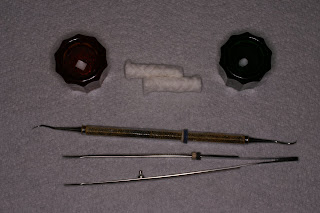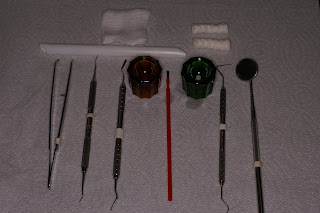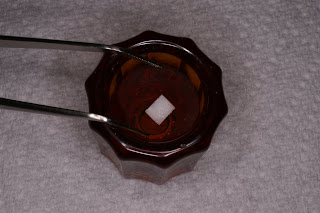Before reading this or
deciding this is a boring and lengthy blog that you have no interest in, I have
a suggestion. Skip to the very last paragraph then decide if you wish to read
the entire article.
I could get into a
discussion about many things that we do not always take the most sensible path –
driving, eating, the way our government operates, etc. but here I am going to
focus on protection against diseases.
In general humans have
come a long way since we have invented the microscope, antibiotics,
disinfectants for home, industrial and medical use, disposable gloves and other
protective barriers. You would think that all the research and education would
have produced some very good habits among us all at work or home. Ironically,
however, the CDC (Center for Disease Control) call their protocol Universal precautions. As I will
point out there is a wide range of understanding and compliance even among all
of us health care professionals. That being the case, how can we expect average
people at home and workers in all other fields to do what is right if we are
not setting a great example.
In my observation I
believe there are two major deterrents to actually developing universal
precautions. One is that we have two major organizations that govern the health
care professions and some other industries. One is the CDC and the other is
OSHA. Neither of these important organizations disperses any false information.
The problem is how some or many workers interpret their manuals. What we all
should be aiming to do is to protect everyone all the time to the best of our
ability. Sadly many show the greatest amount of effort to protect themselves
and not enough toward protecting the patients – both current and subsequent and
also their co-workers. I believe some of their habits are a potential threat to
themselves. I believe this is attributed to having a false sense of security
that many have when wearing disposable gloves.
I have been a Dentist for
40 years. Therefore I have been in the profession throughout several major
transitions. Aside from the changes in procedures – from amalgams to composites, only dentures to the
alternative of implants and many advances that have allowed higher levels of
esthetics, longevity and efficiency through technology there have been a few
monumental changes in infection control. Before 1986 we would do the following:
Wear gloves only when
performing a surgical procedure or on any procedure when a patient was known to
have been exposed to Hepatitis or Tuberculosis.
We wore masks for those
and also if either the patient or we had a cold.
Surgical and Root Canal
Instruments were steam sterilized. General instruments were soaked in a
Gluteraldehyde solution. Equipment and surfaces were wiped with alcohol.
Once we learned about HIV –
AIDS we went through very major changes. We began wearing gloves for all
procedures for every patient. We began using more disposable items, steam
sterilizing all types of instruments and more advanced chemicals for surface wiping.
In addition to HIV there have also been new threats such as several other forms
of Hepatitis and Ebola. The focus on
prevention also lead to further research on bacteria and viruses, parasites in
our water lines. This is another topic I will address at a future date.
The scare about HIV – AIDS
created a very different approach than before. While we previously only wore
gloves and other precautions when we were aware of hepatitis history or were
experiencing cold or flu now the rules became” Treat every patient as a
possible HIV contamination” . We therefore changed our regimen even for the
very simplest procedures and even on family members. We certainly would use a
different approach at home when being intimate with a lover or caring for a
child and overlooking their flaws involving saliva or any other bodily fluid.
However, for a routine exam or any treatment procedure in an office we would
use those universal precautions to prevent contamination when we were 100%
certain that person was not a carrier.
So now let us go back in
time to pre 1985. This is what we were taught. When it was deemed necessary to
wear gloves we first washed our hands then carefully placed the gloves. From
that point we were careful to avoid touching unsterile items with the one
exception being the necessary steps in treatment. When treatment was completed
we carefully removed the gloves, carefully disposed of them and again washed
our hands.
Somehow we have strayed
far from that recipe. I would assume that it is still being used by surgeons in
hospital operating rooms.. The rest of us have wandered far from sensible and effective
and responsible actions.
In addition to practicing
a wide range of general dentistry for the past 40 years, I have also been a
patient at various dental and other medical offices and I have attended many
continuing education classes. From all these encounters and also from my own
office experience – trial and error, observing other dentists, Hygienists and
dental assistants. I learned from those who were employed by me for over 10
years as well as those I interviewed or had for very temporary employment. I
also learned from observing and being treated by Medical Doctors, nurses and
medical Assistants. When I saw something good and impressive I altered my habits
to mimic theirs. When I saw poor habits I made every effort to avoid repeating.
Sometimes these were simply a matter of incomplete knowledge while other times
it was purely being careless. Sometimes I believe that we mean well but are
confused. We may have been taught proper protocol but then get caught up with
the factor of time. Therefore we cut corners. We do not wash hands often. We
touch multiple items some of which never should be contacted with gloved hands
since they cannot be feasibly disinfected.
I believe that part of our
confusion may stem from shows and advertising on television and magazines. Even
our own professional journals and webinar classes will show dental
professionals engaging in controversial behavior. One example I have often seen
is the use of gloves when touching a computer keyboard or mouse. Another is
when using a camera (not intraoral) but regular camera taking photos of a
patient’s face. There really is no feasible way to disinfect your camera or
computer. Chemicals will likely cause at least sticking of parts if not rusting
and deterioration. Part of the confusion comes from crime investigation. Crime
investigators wear gloves for two reasons – to avoid contamination and also to
prevent placing their own finger prints. In order to end that confusion they
really should separate their duties – like we should separate ours. Gloves
should never be worn for taking photographs or using a computer, taking notes
and many other tasks. Just put the gloves on when you are going to contact contaminated areas. Once you are
gloved touch only what is necessary and what can be sterilized, disinfected
readily or disposed. Keep it simple. Keep it safe.
So here now is my current
protocol I use in my dental practice and train my staff.
- Wash hands before preparing for procedures
- Plan ahead and get as much ready as possible
- Position your mask and glasses or eye shields
- Wash hands again
- Put on gloves
- Keep contact of instruments, supplies, equipment to minimum
- If you need to retrieve additional supplies have a second retrieval instrument available
- Make use of a second assistant to place and remove lead aprons for x-rays, remove bibs, fetch additional supplies, take notes, dismiss patients, etc.
- Use gloves on both hands when cleaning up and reassembling instruments and for carting to sterilization area and discarding trash.
- Separate trash into sharps, highly versus minimally contaminated
- Wash hands
- Put away clean items
- Place a glove on one hand only for disinfection. The gloved hand holds the paper towel or cloth with the chemical disinfectant. The ungloved still clean hand contacts poles, door knobs, drawers, hoses, etc. In this way we avoid spreading more contamination than we are removing. The ungloved hand holds the spray bottle.
- Be generous with disinfectant and purposely focus on what was actually contaminated. Be generous with amount, concentration and time spent.
- Remove the one glove and wash hands again.
- One more tip – in the sterilizing room do not wear gloves for any other reason than touching contaminated not yet sterilized instruments.True this is not a sterile world. None of us no matter how hard we try are perfect. If we are going to promote the most good and do the least harm, we need to have sensible methods. We need to be much more similar and not so diverse when it comes to extremely important habits.I will end with a quiz I often give to employees:1] Would you remove your gloves and immediately eat your lunch without washing your hands?2] Is there really a “5 second rule”












